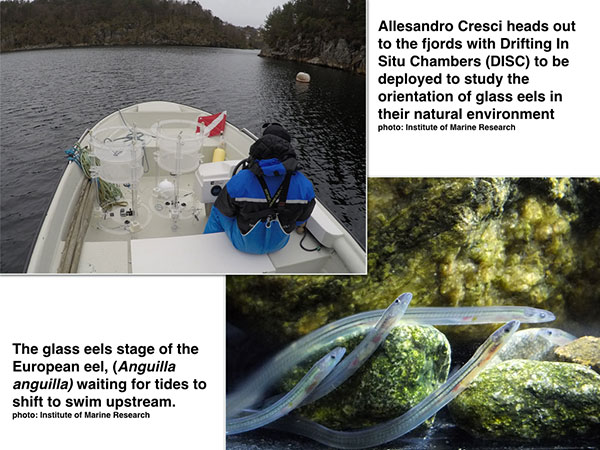Scientists are closer to unraveling the long-standing mystery of how tiny glass eel larvae, which begin their lives as hatchlings in the Sargasso Sea, know when and where to "hop off" the Gulf Stream toward European coastlines to live out their adult lives in coastal estuaries.
In a new study by the University of Miami (UM)’s Rosenstiel School of Marine and Atmospheric Science in collaboration with the Norwegian Institute of Marine Research's Austevoll Research Station found that these glass eels (Anguilla anguilla) can sense Earth’s magnetic field and use it like a compass controlled by an internal “biological” clock to orient themselves towards the coast.
“This study is an important addition to our understanding of the mechanisms of eel migration and also to that of other species, if it turns out that their magnetic orientation is similarly controlled by a biological clock,” said UM Rosenstiel School Professor Claire Paris, a senior author of the study.
The odyssey of the European eel begins when they hatch in the Sargasso Sea. As tiny larvae, they travel thousands of kilometers across the Atlantic Ocean, hopefully making it to the European continental shelf. At some point between the Canary Islands and northern Norway they “hop off” the Gulf Stream and actively migrate towards the coast, heading for estuaries. Some eels remain in the coastal area, while others move inland into lakes, remaining there, slowly growing, for up to 30 years.
 The research team led by UM Rosenstiel School Ph.D. student Alessandro Cresci investigated the orientation behavior of the eels using a unique combination of experiments. First, they observed the eels in a semi-enclosed, circular aquarium, called a Drifting In-Situ Chamber (DISC) pioneered by Paris, deployed in a Norwegian fjord, a natural environments of the glass eel just before it arrives at the coast. The next step was to conduct an orientation behavior analysis in a magnetoreception test facility (the "MagLab"), where they were exposed to artificially manipulated magnetic field such that the N-S and E-W axes were shifted by 90 degrees.
The research team led by UM Rosenstiel School Ph.D. student Alessandro Cresci investigated the orientation behavior of the eels using a unique combination of experiments. First, they observed the eels in a semi-enclosed, circular aquarium, called a Drifting In-Situ Chamber (DISC) pioneered by Paris, deployed in a Norwegian fjord, a natural environments of the glass eel just before it arrives at the coast. The next step was to conduct an orientation behavior analysis in a magnetoreception test facility (the "MagLab"), where they were exposed to artificially manipulated magnetic field such that the N-S and E-W axes were shifted by 90 degrees.
Although deprived of all other environmental cues, glass eels in the laboratory oriented to the South, the same direction that they swam in situ during the ebb tide.
“It is incredible that these small transparent glass eels can detect the earth's magnetic field. The use of a magnetic compass could be a key component underlying the amazing migration of these animals,” said Cresci, the study’s lead author. “It is also the first observation of glass eels keeping a compass as they swim in shelf waters, and that alone is an exciting discovery.”
The study was designed to understand how the fish orient while drifting with the current under the same environmental conditions that they would encounter during their migration towards the coast to assess whether they use Earth's magnetic field as a frame of reference for orientation, and change direction according to the tidal cycle to guide them towards the coast.
When eel larvae arrive at the continental shelf, they metamorphose into transparent glass eels, changing shape, physiology and behavior. At some point during this journey—anywhere from the Canary Islands to northern Norway—they “hop off” the Gulf Stream and actively migrate towards the coast, heading for estuaries. Some eels remain in the coastal area, while others move inland into lakes remaining there, slowly growing, for up to 30 years.
The study, titled “Glass eel (Anguilla anguilla) have a magnetic compass linked to the tidal cycle,” was published June 9, 2017 in the journal Science Advances. The study’s co-authors include: Paris and Cresci from the UM Rosenstiel School; Howard Browman, Steven Shema, Reidun Bjelland, Caroline Durif and Anne Berit Skiftesvik from the Norwegian Institute of Marine Research.; and Steven Shema of Grótti ehf.
Funding for UM from OTIC-NSF Award 1155698 “T-LEOST (realTime-Larval Environment and Ocean Signal Tracking): An Integrated System for the Study of Navigational Cues in the Marine Environment”



